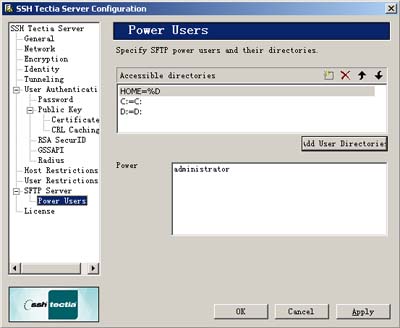Windows平台下我告别了Telnet,SSH才是王道
Telnet作为Windows Server的一个服务曾经非常的实用,但是因为其功能简单并且存在安全问题,所以越来越多的用户开始抛弃他,况且现在很多windows用户都使用remote desktop,哪里还会使用终端command line这种老掉牙的方式,但是我却遇到了这种情况。因为我的个人服务器在网通线路,而我所在的办公室使用的是电信线路所以经常要忍受蜗牛的速度远程桌面到服务器上作一个很简单的操作。感觉还是在CMD下比较方便,之前使用telnet,感觉还凑合,但是一想到密码以明文方式在网络上传送,我就直冒冷汗。总不能单独建立一个帐号只允许telnet,并且IPSec一个信任IP吧!那样岂不是太繁琐了!
所以最终吸取Linux的优异功能——SSH,本来一直以为SSH只能在Linux下运行,后来Google了一下才知道自己的知识面是多么窄!汗!~ing
SSH的功能性和安全性是众所周知的,所以Linux家族已SSH作为默认的远程连接服务。SSH的另外一个吸引我的功能是可以通过SFTP轻松的实现文件管理。
通过朋友介绍和自己筛选,最终选择了SSH的本家出品的软件:SSH Tectia Server,当前最新版本是:4.3.4.16,呵呵忘记介绍这是一款商业软件。官方网站:http://www.ssh.com,它主要用在银行证卷等领域,顶级产品!所以我选择它,我喜欢最好的!不过我使用了不地道的CR,别怪我!我没钱
安装很简单下载到软件直接运行就可以了!

安装后需要做几个小的设置,当然你也可以不做。
1、设置允许登录的帐号和不允许登录的帐号,SSH Tectia Server 默认允许 administrator 帐号登录,如果你有多个管理员和用户,你可以设置哪里可以 SSH 连接,哪些设置为禁止,这样有助于提高安全性!

2、设置你的资源访问,如果你的分区没有在这里列表中你就需要添加。默认的是C和D,HOME=%D代表用户配置文件中的主目录,也就是你Windows下用户目录。当然你也可以设置为其他的作为SSH登录后的ROOT

整体感觉还是很简单的,其他功能没有仔细研究,以后慢慢来吧!
从命令提示符执行 IIS 中的管理任务
概要
锐捷2126G交换机流控配置单
1、特权下设置访问控制列表,允许所有的IP地址访问。
ip access-list standard aa
permit any
2、设置一个CLASS组,对访问控制列表AA进行验证
match access-group aa
3、设置一个优先组mm,使用CLASS组bb
class bb
police 5000000 37268 ex drop(设置流控,速率范围是1M-100M概值是1000000-100000000后面的37268不变)
4、在端口上应用流控策略mm
service-policy input mm
结束……
也可以封掉一些端口来减少带宽利用!




























